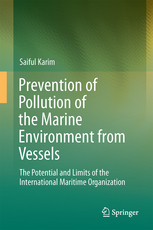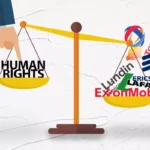The book under review is a recent contribution to the marine environmental law and policy by a young scholar of Bangladeshi origin, who is currently teaching at Queensland University of Technology Law School, Australia.
 Today, we live in an increasingly risky world in which sources of threat to our lives and livelihood reside not only in politics, terrorism, and abuses of religions, but also in environmental degradation and calamities. The recent instance of huge spillage of oil from a ship plying in a river that passes through the Sundarbans in Bangladesh is but an example of catastrophic, life-threatening consequences of no or sham regulation of human or governmental behaviour vis-à-vis environment. At the international level, the discourse of marine environmental protection is, therefore, never likely to be fading, but rather attracting new insights.
Today, we live in an increasingly risky world in which sources of threat to our lives and livelihood reside not only in politics, terrorism, and abuses of religions, but also in environmental degradation and calamities. The recent instance of huge spillage of oil from a ship plying in a river that passes through the Sundarbans in Bangladesh is but an example of catastrophic, life-threatening consequences of no or sham regulation of human or governmental behaviour vis-à-vis environment. At the international level, the discourse of marine environmental protection is, therefore, never likely to be fading, but rather attracting new insights.
Generally under international law, States have an obligation to prevent pollution of seas from ships or other sources such as waste disposal or developmental undertakings. With the establishment of the International Maritime Organization (IMO) as a specialized agency of the United Nations in 1958, the law in this field started becoming increasingly treaty-based with international mechanisms for oversight and enforcement. The IMO was given the mandate “to provide machinery for cooperation among governments for the prevention and control of pollution of the marine environment from vessels” (p. 1). It also was endowed with the specific responsibility of drafting legal instruments as well as facilitating technical cooperation for the protection of the marine environment.
The book “Prevention of Pollution of the Marine Environment from Vessels” critically examines the role of IMO in the prevention and control of pollution of the marine environment from vessels “with a particular reference to the current north-south tensions regarding the strategy for combating climate change in the maritime sector as well as the prevention of marine pollution from the ship-breaking industry” (p.1). The book indeed provides a clear view of the potential and the limits of this member-driven international organization both as a regulator and a facilitator with respect to the prevention of vessels-source marine pollution. Of particular note is the book’s capture of the liberal progression of IMO’s legal instruments towards a more expanded mandate of this organization such as the one that aims at preventing marine pollution from ship breaking, which is essentially a land-based industry and hence was not within its original ambit.
The author’s plan is neatly translated through eight chapters, beginning with the introduction of the subject matter in Chapter 1 that usefully, albeit briefly, contains a developmental account of IMO-instruments and structures for the prevention of vessels-source marine pollution. Chapter 2 discusses the institutional structure and lawmaking process of the IMO in further details. This chapter is an exploration of the IMO’s mandate in the light of its constituent instrument and other international laws as, for example, the Law of the Sea Convention 1982. Chapter 3 of the book, titled Pollution prevention, response and compensation, specifically covers IMO’s most significant 1973 Convention against marine pollution from ships and other ‘liability and compensation conventions’. It also analyses the legal regime relating to ‘particularly sensitive sea areas’ and oil pollution preparedness, response, co-operation and intervention.
Chapter 4 deals with unconventional sources of pollution generated by international ships, which are otherwise known as “unintended” environmental impact of international shipping. It deals with the impact of ships’ ballast water and biofouling that introduce to the marine environment harmful or invasive aquatic organisms, which are a source of danger for biodiversity. Chapter 5 deals with the recycling of ships, flagging the need for looking at ships-breaking as an ultra-hazardous industry. Despite its being a land-based industry, the nature of the pollution it produces made it a subject matter of IMO’s regulatory regime. This development is inescapably entwined with the so-called north-south divide amongst the States with respect to the duty to prevent and protect the marine environment. This chapter draws important insights into this old aspect of international politics regarding the climate change and/or environmental protection discourses.
Closely knitted with the fifth chapter is Chapter 6 of the book that takes on an analysis of the duty of States to reduce emission of greenhouse gases from ships. As the author claims, this contemporary issue of marine environmental protection brought forth into the IMO’s lawmaking process the just mentioned north-south debate, taking the clue from the UN Climate Change Convention and the negotiations that preceded it. This chapter critically analyses this political tension in the light of certain crucial issues such as the principle of ‘common but differentiated responsibility’ (CBDR) and the obligation of technology transfer in favour of the states in the global South to help them better fight marine environmental pollution.
Chapter 7 specifically deals with the problem of implementation of IMO’s legal instruments and discusses the role of technical and financial cooperation in increasing the rate of rules-compliance. Undoubtedly, the poor state of marine environmental protection is imputable more to the lack of political willingness or of financial resources and technical ability amongst the breaching States than to the lack of adequate laws. The author insightfully identifies the over-reliance on flag State enforcement of relevant laws as a “major” cause of regulatory deficiency of the IMO, and highlights the fact that developing countries lag behind in optimally enforcing IMO’s anti-pollution conventions. Importantly, this chapter not only analyses the politics of enforcement of IMO-laws, but also focuses on the indifference of Northern States as to the need for transferring technology and rendering financial assistance to Southern States, as well as the practical problem of lack of resources/expertise on the part of developing economies that are flag States.
Chapter 8 is the concluding chapter and it briefly summarizes the findings and analyses made in the preceding chapters. The author is empirically supportive of the fact that IMO has expanded its role and activity in protecting the marine environment from vessels-source pollution. One of the striking features of this book has been its focus on the needs and contexts of the developing countries. Also notably, the author argues that the lack of effective measures at the global level to give effect to the common but differentiated responsibility has led to developing nations’ significant non-compliance with international obligation to prevent pollution from marine vessels. Plausibly, however, the author also points out that the developing nations should not scruple to comply with the rules by claiming lack of financial resources.
Overall, the book presents a complex issue in an attractively simple way. The author’s arguments are appealing and, more so, they are presented in a concise but pointed narrative. Law students, lawyers, judges, academics, and of course anyone interested in a critical overview of the IMO marine environmental legal instruments would find this book extremely important. As a reviewer, I can but appreciate the book’s pleasant revival of the ‘north-south tension’ and the CBDR-debate within the framework of marine environmental protection discourses from a global perspective.
Prevention of Pollution of the Marine Environment from Vessels: The Potential and Limits of the International Maritime Organisation
By Saiful Karim
Heidelberg; New York; London: Springer, 2015), XVI + 172p + 1 Illust.; Hardback, £72.













No Comments
Leave a comment Cancel